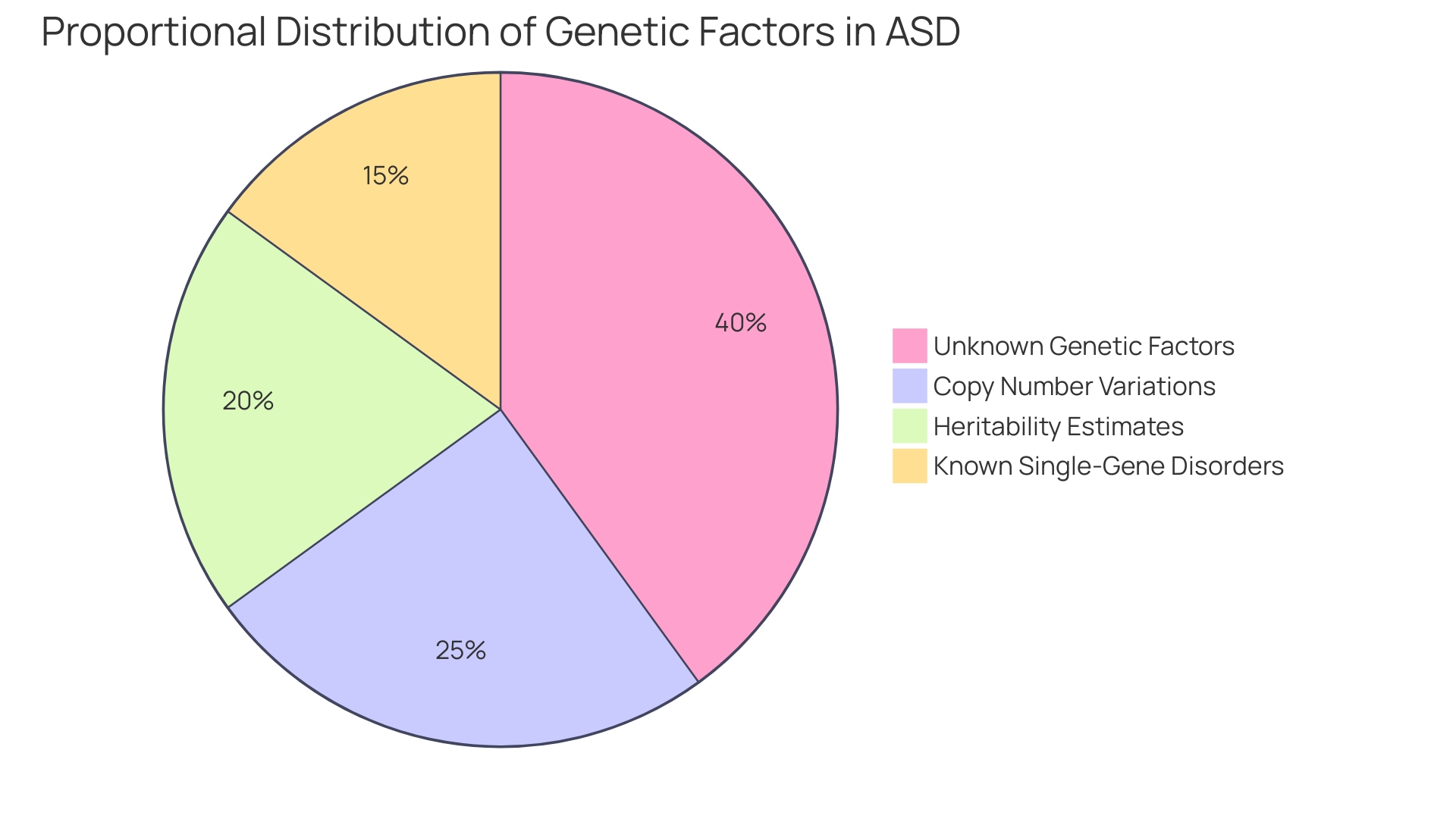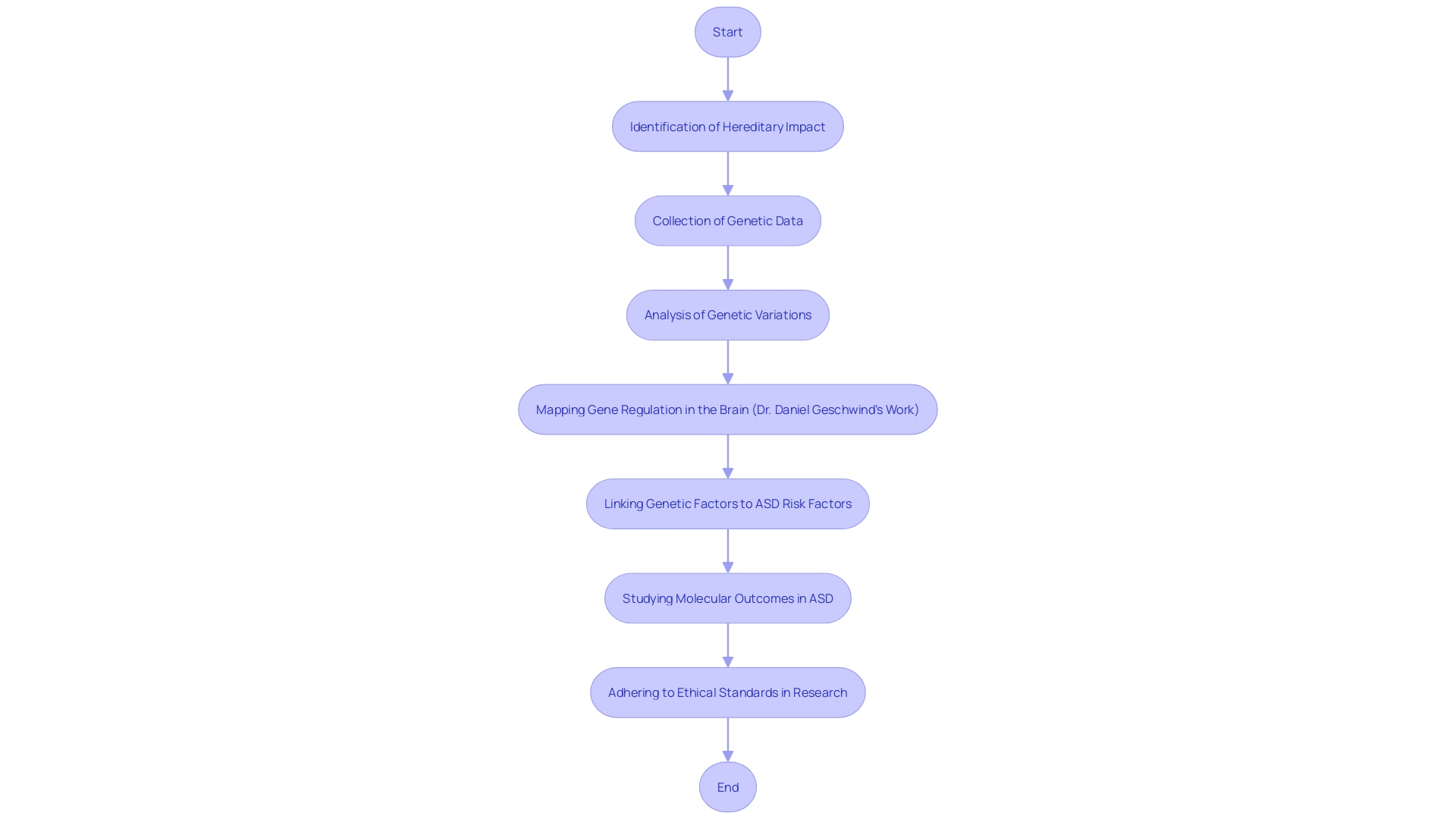Introduction
The intricate tapestry of genetics is central to our understanding of autism spectrum disorder (ASD). It's widely recognized that genetics are a significant factor, with research indicating a strong hereditary link. In fact, the heritability of autism is underscored by the observation that certain genes may increase the likelihood of an individual developing ASD.
Diving into the genetic underpinnings is more than an academic pursuit; it's a vital step towards crafting personalized interventions that could transform lives. Studies conducted with rigorous ethical standards, such as those approved by the Danish Data Protection Agency, lay the groundwork for this exploration. These studies adhere to strict privacy protections, ensuring that personal identifiers are kept confidential within the research team.
This approach not only advances our scientific knowledge but also safeguards the dignity and privacy of participants. As we continue to decode the genetic language of autism, each discovery brings us closer to a future where tailored support and treatments are a reality for those on the spectrum.
The Role of Genetics in Autism
The complex fabric of genetics is crucial to our comprehension of spectrum disorder (ASD). It's widely recognized that genetics are a significant factor, with research indicating a strong hereditary link. In fact, the heritability of autism is underscored by the observation that certain genes may increase the likelihood of an individual developing ASD. Delving into the underlying foundations is more than an academic pursuit; it's a vital step towards crafting personalized interventions that could transform lives. Studies conducted with rigorous ethical standards, such as those approved by the Danish Data Protection Agency, lay the groundwork for this exploration. These studies uphold stringent privacy safeguards, guaranteeing that personal identifiers are maintained confidentially within the team conducting the investigations. This approach not only advances our scientific knowledge but also safeguards the dignity and privacy of participants. As we continue to decipher the language of autism, each discovery brings us closer to a future where customized support and treatments are a reality for those on the spectrum.

Heritability of Autism Spectrum Disorder (ASD)
Genetic studies have made significant strides in comprehending Autism Spectrum Disorder (ASD), unveiling its strong hereditary component. Studies underscore the role of genetics by showing that when one identical twin is diagnosed with ASD, the likelihood of the other twin also being affected is notably high. This indicates a strong hereditary impact on the disorder's manifestation. The integrity of this study is emphasized by the rigorous ethical standards, including approvals from oversight bodies like the Danish Data Protection Agency. Further, recent groundbreaking work, such as that led by neurogeneticist Dr. Daniel Geschwind, is pioneering new ways to map gene regulation in the brain. Geschwind's team aims to clarify the complex connection between risk factors related to genes and their molecular outcomes in ASD, an effort that offers to enhance our understanding of ASD at the cellular and circuit levels.

Common Genetic Variants Associated with Autism
Recent advancements in DNA research have revealed insights into the complex connection between our genetic makeup and the onset of a neurodevelopmental disorder. A group of hereditary differences, widely shared among individuals with a neurodevelopmental disorder, has attracted the interest of the scientific community. These genetic factors are crucial in the orchestration of brain development and its functions. Through meticulous analysis of these variations, there is an optimistic hope that we might unravel the complexities of the biological underpinnings of autism.
For example, in one moving case, a child with intellectual disabilities, including non-verbal developmental disorder, was involved in a national genomics project. After extensive testing failed to provide insights, researchers discovered a de novo microdeletion affecting genes related to cognitive development. Such findings have profound implications, suggesting that even minute alterations in the genome can have significant impacts on neural development.
As scientists keep mapping these genetic territories, the objective is not only to comprehend but to spearhead targeted interventions that can address the specific needs of individuals with a developmental disorder. Backed by strong moral principles and thorough scientific methods, these endeavors demonstrate a joint dedication to improving the quality of life for individuals impacted by the condition. The commitment to this cause is demonstrated by investigations approved by the Danish Data Protection Agency, reflecting a dedication to upholding both scientific integrity and the welfare of participants.
De Novo Mutations and Their Impact on Autism
Advancements in genetic investigation have begun to illuminate the intricate role of de novo mutations—spontaneous hereditary changes not inherited from parents—in the development of autism spectrum disorder (ASD). These mutations, often identified through detailed DNA sequencing and analysis of gene variants, can interfere with normal brain development, potentially leading to ASD's characteristic cognitive and behavioral traits. Healthcare professionals, armed with a comprehension of these disruptions, confront the intricate duty of connecting particular gene variations to a patient's symptoms, especially when less is known about the gene's function and its related disorders. Studies, such as those led by neurogeneticist Dr. Daniel Geschwind, aim to bridge the knowledge gap by mapping gene regulation across the brain's various regions and developmental stages. Geschwind's research, along with others in the field, aims to decode the molecular changes correlating with susceptibility to ASD and understand these changes at the cellular and circuit levels within the brain. Such understanding is important in unraveling the underlying foundations of autism spectrum disorder and could pave the way for targeted interventions.
Gene-Environment Interactions in Autism Development
Autism spectrum disorder (ASD) is not solely dictated by genetics; the interplay between genes and environmental factors is critical in understanding its development. Prenatal and early-life experiences, for instance, can modify genetic predispositions, modulating the risk of ASD. It's crucial to acknowledge that genetics is not predetermined when it comes to the condition, as there is a intricate interplay between our DNA and the world we encounter from conception onwards. The complex connection between our genes and the environment emphasizes the necessity for multidisciplinary investigation to uncover the enigmas of ASD. With scientists like Krogan employing quantitative biological approaches, we are beginning to see the larger picture, linking seemingly unrelated conditions through molecular commonalities. This comprehensive perspective allows for innovative therapies that could be relevant to a range of conditions, including individuals with autism. To achieve this objective, thorough investigations, such as those sanctioned by the Danish Data Protection Agency, are carried out with strict ethical principles, guaranteeing the preservation of the study's integrity while safeguarding the privacy of the individuals involved.
Environmental Factors That Increase Autism Risk
The interaction between inherited tendencies and external factors is a fundamental aspect of autism spectrum disorder (ASD) investigation. While prenatal exposure to specific medications, environmental toxins, and infections, as well as maternal health conditions, have been implicated as potential risk factors, it's crucial to understand that they do not singularly cause ASD. These environmental factors, transient and varied as they may be, contribute to the risk in conjunction with genetic susceptibilities.
Recent research has provided a clearer picture of how these elements interact. In a thorough investigation, under the supervision of the Danish Data Protection Agency, researchers used extensive phenotypic data from a large group to uncover patterns of a developmental disorder and its related characteristics. Their findings highlight the nuanced hereditary and molecular programs connected to different presentations of autism.
Moreover, groundbreaking efforts by the consortium led by UCLA neurogeneticist Dr. Daniel Geschwind are bridging the gap between genetic risks and molecular causal mechanisms. Dr. Geschwind's research emphasizes the importance of understanding gene regulation across various brain regions and developmental stages. His approach moves beyond traditional bulk tissue studies, which are limited in their capacity to reveal specific brain layer and cell type variations linked to ASD.
As researchers like Dr. Geschwind point out, the challenges of delineating environmental factors are significant. The complexity of environmental assessments is underscored by the inability to capture the full spectrum of exposures, from prenatal pathogens to socioeconomic factors, excluding the consideration of individuals with autism. The transient nature of these factors further complicates their quantification and the understanding of their long-term impacts.
In general, understanding the intricate nature of ASD, both in terms of its biological and clinical aspects, is not only difficult but also crucial. With the ethical rigor and methodological advancements in recent studies, the scientific community is making strides in identifying how these multifaceted risk factors converge to affect individuals with the neurodevelopmental disorder.
The Importance of Genetic Testing for Autism
Testing of genes offers a glimpse into the intricate hereditary landscape of ASD, pinpointing genetic variations that could be linked to the condition. Such insights not only enhance our comprehension of ASD's roots but also pave the way for more personalized approaches in managing it. For families with a history of autism, testing might shed light on recurrence probabilities in subsequent pregnancies. It's a powerful tool that, when coupled with informed consent and ethical research practices, can significantly shorten the diagnostic journey for ASD, which often spans years. Realizing that early intervention leads to more favorable outcomes, it becomes clear why timely and precise DNA testing is vital. Moreover, understanding the genetic underpinnings of ASD helps in grasping the dynamic interplay between genetic predisposition and environmental triggers, which is essential for crafting targeted treatments and supports. As research progresses, we inch closer to developing strategies that can transition individuals from being at risk to leading fulfilling independent lives.

Conclusion
In conclusion, genetics plays a significant role in autism spectrum disorder (ASD), with a strong hereditary link and certain genes increasing the likelihood of developing ASD. Understanding the genetic underpinnings of autism is vital for personalized interventions that can transform lives. Studies with rigorous ethical standards, like those approved by the Danish Data Protection Agency, protect participants' privacy and dignity.
Recent breakthroughs in genetic research have deepened our understanding of ASD at the cellular and circuit levels by mapping gene regulation in the brain. Common genetic variations shared among individuals with autism have been identified, highlighting the intricate relationship between our DNA and the condition's onset. Even small alterations in the genome can have significant impacts on neural development.
Advancements in genetic research have also shed light on the role of de novo mutations in ASD, which can interfere with normal brain development and contribute to the disorder's cognitive and behavioral traits. Mapping gene regulation across different brain regions and developmental stages is essential for decoding the molecular changes associated with genetic susceptibility to ASD.
While genetics are important, the interplay between genes and environmental factors is critical in understanding ASD's development. Prenatal and early-life experiences can modify genetic predispositions and influence the risk of ASD. Multidisciplinary research is necessary to unravel the complexities of ASD and its environmental influences.
Genetic testing offers valuable insights into the genetic landscape of ASD, aiding in the identification of variations linked to the condition. Understanding the genetic underpinnings of ASD is crucial for developing targeted treatments and supports. Timely and precise genetic testing is vital for early intervention and better outcomes.
Each discovery in decoding the genetic language of autism brings us closer to a future where tailored support and treatments become a reality for individuals on the spectrum. Ongoing advancements in genetic research empower us to navigate the challenges of autism and ensure the well-being of our children.




